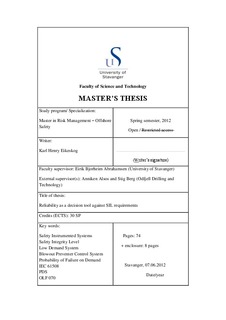| dc.contributor.author | Eikeskog, Karl Henry | |
| dc.date.accessioned | 2012-10-22T08:05:21Z | |
| dc.date.available | 2012-10-22T08:05:21Z | |
| dc.date.issued | 2012 | |
| dc.identifier.uri | http://hdl.handle.net/11250/182066 | |
| dc.description | Master's thesis in Risk management | no_NO |
| dc.description.abstract | Safety Instrumented Systems (SISs) is used in the oil and gas industry to detect the onset of hazardous events and/or to mitigate their consequences to humans, material assets, and the environment. International standards have been developed to ensure that a SIS is designed, implemented and operated according to the specified needs. Safety and reliability assessments play an important role in SIS design, construction and operation.
In this thesis there is carried out a reliability study of the BOP control system on Deepsea Atlantic (DSA) with use of the international IEC 61508 standard and the Norwegian PDS guidelines. All the results show that the BOP control system is within the requirements given by OLF 070.
The results from a reliability study will vary because of different interpretations in the guidelines. Factors that contribute to a change in the unavailability is identified in both methods and highlighted with examples throughout this thesis. The major difference between the two methods is that PDS guidelines include more details in the calculation of Common Cause Failure (CCF). In a calculation example given in this thesis, the two guidelines conclude against different Safety Integrity Levels (SILs).
If decision makers are not aware of assumptions and conditions in the methods, they may misinterpret the results and select a SIS design that is either too complex or too simple to provide necessary risk reduction.
In the oil and gas industry it is common to define and describe risk using probabilities and probability distributions. The Probability of Failure on Demand (PFD) gives a useful insight for decision makers. After presenting several examples of how different interpretations in the methods results in different SIL verification, I argue that there is a need for broader reflection of robustness and uncertainties, which can support decision makers when verifying against SIL requirements. Therefore, I present some new ideas of how one can merge existing approaches to support decision making. Today, it seems to exist no overall agreement or guidelines of how one can verify the PFD against the SIL requirements. | no_NO |
| dc.language.iso | eng | no_NO |
| dc.publisher | University of Stavanger, Norway | no_NO |
| dc.relation.ispartofseries | Masteroppgave/UIS-TN-IØRP/2012; | |
| dc.subject | risikostyring | no_NO |
| dc.subject | offshore sikkerhet | no_NO |
| dc.subject | safety instrumented systems | no_NO |
| dc.subject | safety integrity level | no_NO |
| dc.subject | low demand system | no_NO |
| dc.subject | blowout preventer | no_NO |
| dc.subject | probability of failure on demand | no_NO |
| dc.subject | iec 61508 | no_NO |
| dc.subject | pds | no_NO |
| dc.title | Reliability as a decision tool against SIL requirements | no_NO |
| dc.type | Master thesis | no_NO |
| dc.subject.nsi | VDP::Social science: 200 | no_NO |
